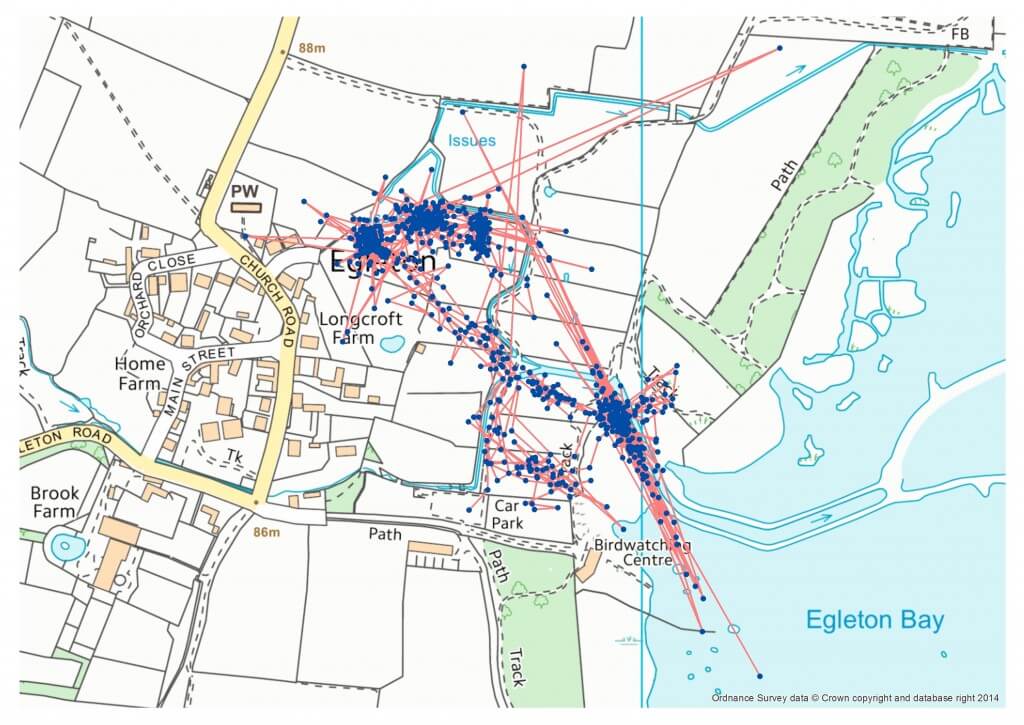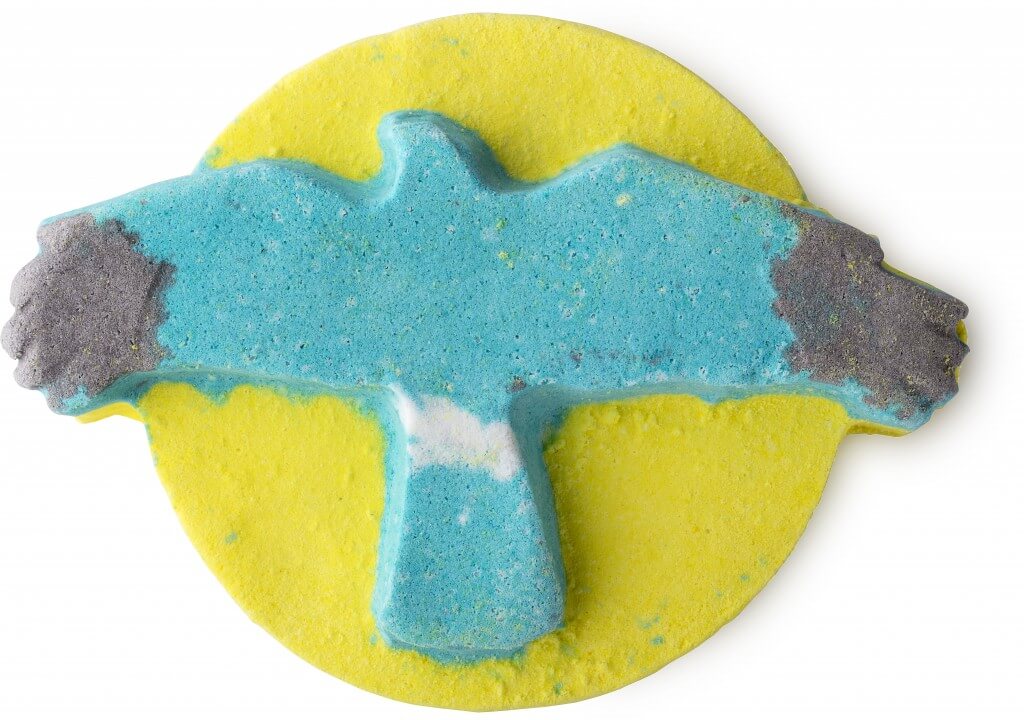
When Henry was at the Bird Fair last weekend he had a satellite tag fitted to him.
You can see that the tag correctly located Henry in Rutland, and correctly located him at the right end of Rutland Water, and correctly mapped his flights around the Bird Fair marquees. You can see how detailed is the information it produced above. The first big blob of dots (far right) was at the BTO ringing demonstration stand where the tag was fitted. The three other collections of blobs are the BAWC stand in Marquee 8, the food and drink stalls nearby (vole-burgers a speciality) and the Authors’ Forum tent. If Henry had suddenly ‘disapppeared’ we would have a good understanding of whether it was at the BTO stand (Marquee 3), the LACS stand (Marquee 7) or the World Land Trust stand (Marquee 2).
There are errors in here too, not surprisingly. Henry did not go for a swim! You can see that whilst actually at the BTO ringing demonstration Henry was sometimes located a couple of hundred yards to the northwest or southeast, and there are a few other outlying points too (unless he really did go zooming off to the northeast from the food stands in pursuit of a Meadow Pipit).
That’s why, when real birds disappear, like Sky and Hope, there is a certain amount of doubt about exactly where they were, although not much doubt at all about pretty exactly where they were.
The frequency of updates was higher for Henry than it would be for a ‘real’ Hen Harrier because this was done to make it more fun, and the accuracy of this tag was a bit higher than it would be for a real tag (because Henry is quite an out-sized Hen Harrier and therefore could carry a bit more weight) but this little demonstration gives you a feel of how the system works.
Tags such as this one should be fitted to many Hen Harrier broods (a type of meddling that should be encouraged) right across the country as we know that these birds travel large distances when young and , many of them, in the winter. We know, from, for example, Bowland Betty’s travels that she might have been in jeopardy several times during her journeys up and down the country.
With enough data one could look at the chance of a bird disappearing (or a tag ‘failing’) on a grouse moor compared with a non-grouse-moor (using satellite imagery of the vegetation passed over). That would be interesting. Male Hen Harriers which ‘disappeared’ when actively engaged in nesting might provide fascinating information too. And we would learn a lot about Hen Harriers that would simply be very interesting.
I see satellite tagging as a great aid to studying birds, including Hen Harriers, a great aid to enforcement of the law (because illegally killed birds can sometimes be retrieved and inform investigations), and a great deterrent to illegal killing of raptors.
They are an important weapon in our armoury against wildlife crime, rather better value for money perhaps than a Wildlife Crime Officer. But the tags aren’t cheap. The one that Henry wore costs about £2000 to buy and another c£1000 for the cost of downloading the data. But if you offered me an extra Wildlife Crime Officer or a dozen satellite tags I’d pick the satellite tags every time. Perhaps the Home Office, Police Scotland and others should be paying for a few hundred satellite tags to be fitted to Hen Harriers, Goshawks, eagles etc as a real attempt to fight wildlife crime?
Doesn’t it make you wish that your taxes had been invested in a study which tagged lots of Hen Harriers so that you would know what happened to them? Oh hang on, they were. More on this later today.
Real Hen Harriers will be tagged by the Hen Harrier Life project.
Buying Skydancer bath bombs will help raise money for satellite tags too. They will lead to the sweet smell of success against wildlife crime.
[registration_form]


When the whole Henry idea was first mooted I’ll be honest and admit I wasn’t 100% sure what the campaign might achieve – but what’s been really striking (apart from how much energy it takes to cover that much ground dressed in a heavy suit!) is how warmly people always react when they see ‘him’. Imagine the revenue/benefit to landowners who could host the real thing if they’d get involved with an eco-tourism programme and set up a flying visit by ‘Henry’ and invite the locals in to meet him…so much more sustainable than backing ever further into a corner which will inevitably lead to them losing all support or goodwill from the public.
The public love a ‘mascot’ and that’s who need the education, get them engaged and the rest will follow. He’s very visible and conversation provoking and that then generates discussions etc.
Henry needs to find a mate then there might be fledglings which could carry the message wider? That’s not to say Henry ain’t doing a fantastic job, but I suspect it can be lonely out there at times?
I bought two bath bombs at the Birdfair and a colleague also bought me one as a surprise present from her local Lush store after I took the time and trouble to explain the issues to her in order to provide a group with an explanation as to why they might like to sign the epetition – which they duly did.
I had naively assumed that after the Birdfair there might be a rush of additions to the epetition, maybe Henry is seen by some as a threat to ‘Bob’ and WT Brock?
Charlie,
As a wildlife photographer myself I bet there would be a real market for any landowners to allow opportunities to photograph these birds at or near to the nest.
Nearly every other iconic UK species now has a photography hide or workshop dedicated to it allowing ideal opportunities to get cracking shots, fish farms are realising the value of visiting ospreys and are prepared to take a loss in trout in return for the money paid by photographers. Red Kite feeding stations, Pine Marten hides etc etc, Hen Harriers would draw in money and may go some way to offsetting the loss of grouse. Combine it with some diversionary feeding which has proven to work and you never know, the moor owners could make money from 2 revenue streams (photography and shooting) whilst at the same time contributing towards conservation.
Ben – it’s a nice idea which has something going for it. Indeed, the Glen Tanar Estate did do something like this for Hen Harriers and Golden Eagles I believe. But there are several hundred grouse moors in the UK and they aren’t all going to make a living out of flogging days in photography hides for hundreds of pounds when some of them can flog days of grouse shooting for thousands of pounds, I fear. No, we have to choose between a pointless, economically worthless ‘sport’ and birds of prey, blanket bogs and uplands which deliver much more to the public as a whole in return for our massive financial investment. Ban driven grouse shooting – that’s the answer.
It is fascinating. I came across a website showing the movements of Gulls tagged at a colony on the Suffolk coast South of Minsmere. From their apparently random visits round the countryside, with the aid on Google satellite images, you could identify the visits they made to free range pig farms. (some developed since the images taken)